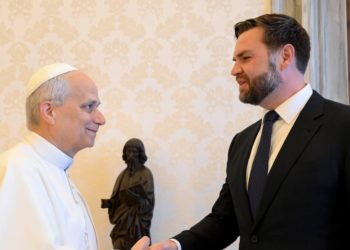Three days after an explosion believed to be intended for a fertility clinic rocked the city of Palm Springs, California, the smell of smoke still filled the air.
Portions of the blast zone around the American Reproductive Centers are fenced off but Palm Springs Police Chief Andy Mills allowed CBS News to get a look at the damage.
Chief Mills — who was among the first to respond to the scene on North Indian Canyon Drive that Saturday morning — said the suspected bomber backed his Ford Fusion into a parking spot and that now has a crater created by the powerful explosion.
Part of the vehicle’s engine still sits in the middle of that lot on the east side of the IVF clinic, which houses its offices, and shrapnels are buried in the stucco walls of surrounding buildings.
The suspect, 25-year-old Guy Bartkus was killed in the explosion, the FBI confirmed following DNA testing, and four other people were injured in the explosion. None of the victims is believed to be staff members of the clinic, city officials said.
Investigators say the blast pattern shows that the device was far more damaging than a low-grade explosive such as fireworks. The bomb used was identified as a large, “vehicle-borne improvised explosive device,” according to two sources familiar with the investigation. Its blast could be felt more than a mile away from the blast zone, the FBI said.
With a massive blast radius, there were more than 150 members of law enforcement at the height of the investigation sifting for evidence, Chief Mills said. FBI teams used drones, 3D scanners and bomb-sniffing dogs to map out fragments and trace the chemicals that may have been used for the car bomb.
Thanks to tips from the public and surveillance videos, authorities told CBS News they are piecing together what happened between the suspect’s arrival in Palm Springs at 6 a.m. local time Saturday and the time the bomb went off at 11 a.m.
Bartkus was a resident of Twentynine Palms, home to a large Marine Corps base about an hour’s drive from Palm Springs, the FBI said. He stated in writings or recordings that he was against bringing people into the world against their will, according to law enforcement sources familiar with the investigation.
Detectives believe Bartkus acted alone at the site but said they’re scouring his online chats to learn whether anyone helped him buy parts or refine the design of the bomb.
“I’m going to stand firm on … if you see it and you didn’t say something, then you’re as morally responsible for what took place as the person who pulled the trigger,” Mills said.
The IVF clinic is still too unstable for employees to enter, authorities said. Once all the evidence is collected, the building may have to be demolished.
Andres Gutierrez is a CBS News reporter based in Las Vegas. Most recently a reporter with CBS News Detroit, Andres brings more than a decade of award-winning breaking news reporting and fill-in anchor experience across several markets including Kansas City, Missouri and Dallas, Texas. While covering Detroit, he reported on major national stories, including the mass shooting at Michigan State University, and the historic six-week strike by the United Auto Workers. Gutierrez also played a major role in CBS News and Stations’ in-depth coverage across platforms of the trials of James and Jennifer Crumbley – the first parents in the U.S. to be held criminally responsible for a school shooting committed by their child. Gutierrez graduated from New York University and is a member of the National Association of Hispanic Journalists.
The post Inside the blast zone following bombing at Calif. fertility clinic appeared first on CBS News.




